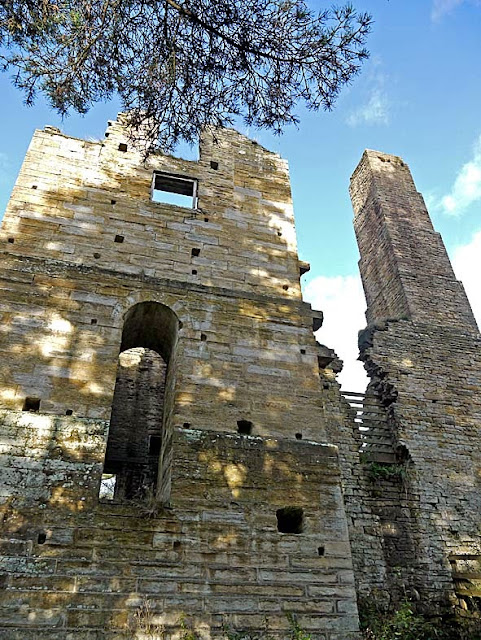It's difficult to believe now that this beautiful landscape was once so devastated by industrial pollution that it was chosen as the set for the movie Alien 3. For much of the 20th. century coal mine waste from
Dawdon colliery on the cliff top was carried via conveyor belts and dumped directly onto Blast beach where, along with blast furnace waste , it converted the sand below the cliffs into a black, sulphurous moonscape. Then, in 1991 the mine closed and at the millennium the clean-up began. Since then, nature has rapidly reclaimed the landscape: marine life is returning below the tide line, sea birds nest on the cliffs and there are wild flowers at the top of the beach. It's an inspirational transformation.
The limestone cliff-top flora at some locations along this stretch of coastline has always been famous, with drifts of wild flowers like this bloody cranesbill .......
....... and thickets of coconut-scented gorse, but now that this stretch of coastline has come under National Trust stewardship the floral display extends for miles.
The fast eroding magnesian limestone cliffs are good nest sites for birds ......
....... and on most days you can watch kestrels riding the updraft .....
.......... and find stonechats in the cliff-top thickets ...
..... but it's down as sea level that the real transformation has taken place, with sand rapidly replacing the barren wastes of coal and rock that once made the beach impassible.
The whole award-winning
Turning the Tide enterprise has been a superb collaborative effort and the source of enormous local pride.
Who wouldn't be proud of a coastal landscape like this?
If you look hard enough there are still traces of the industrial past - like this brick stamped with the
Marquess of Londonderry's name. It was he who, in 1907, opened Dawdon colliery that gave employment to hundreds of local people but whose waste materials poured out onto the beaches.
There are still traces of coal amongst the rocks and pebbles on the beach, but every high tide washes more of it away.
There are other, prettier artifacts too.
A glass bottle factory once stood on the cliffs here, using local coal and sand from the beach to produce glass that was exported to London. The bottle works closed in 1921 but waste glass that was thrown into the sea and is still washed ashore .......
......... as sand-polished glass pebbles that are highly prized by local jewellers..
At the top of the beach there are still strange mineral deposits and incrustations that are a legacy of past mining ....
... and have a weird beauty all of their own .

.......... staining the rocks with iron deposits ...
........ but every year more wild flowers appear at the top of the beach, like these harebells ......
.......... hundreds of primroses that flower in spring where the cliffs have collapsed onto the beach
........... and yellow-wort that flowers in the short grassland under the cliffs.
One of the interesting botanical features of this beach is the Phragmites reed bed under the cliff......
.....this is growing in brackish water but depends on the protection of the raised beach formed from former coal dumping. When this eventually erodes away salt water will reach the cliff base on high spring tides and the reed bed will most likely disappear.

Hawthorn hive, the next bay to the south of Blast beach, suffered similar pollution from Blast beach's colliery waste that was swept along the coal and deposited there, filling the bay with a raised beach of concreted coal dust, crushed rock and sand. .......... but the flora and fauna at the top of the beach on the right of this photograph is rather special. The cliff provides shelter from prevailing south-westerly winds and is a sun trap for much of the day, so this spot is warmer than most places along this coast.
It's a long climb down the cliffs on steep winding steps that descend .......
... beside wooded ravines.
The view back from the beach reveals the extent of the tree cover ....
.......... and in spring there's a dazzling display of blackthorn blossom.
But it's the calcareous grassland below the cliffs that is most fascinating.
It's covered in orchids in early summer........
...... alongside classic seaside flowers like this sea pink that clings to the cliff .....
........... thickets of wild roses .....
.......... and also some colourful and unusual garden escapes, like this Montbretia.
The warmth and shelter make this a particular good place to find unusual sun-loving insects, like this iridescent ruby-tailed wasp that nests in the sand .......
........ while more than a dozen species of butterfly can be found here, including common blues
........ and peacock butterflies.
The irony is, though, that the survival of this cliff base flora and fauna depends on the raised beach created by mining waste pollution from the past. It breaks the force of the waves and without it salt water would reach the base of the cliffs during high spring tides reinforced by north-easterly gales, destroying all the flora and fauna in its path.
Now that mine waste dumping no longer occurs, every tide washes away a little more of the raised beach, revealing mining artefacts from the past. Twisted metal .......
.........and materials from the 20th. century mining industry.......
.......... including sections of conveyor belt that once carried the mining waste onto the beaches.
With rising sea levels, the day will come when the sea will finally wash away this raised beach and with it the butterflies, ruby-tailed wasps and orchids at the top of the beach ............. and then it will eat into the cliffs themselves, eroding them .... but for now, by accident, the pollution from the mining industry has created a sheltered haven for some exquisite wildlife.
For more pictures of wildlife along this coastline today, click
here and
here


























































